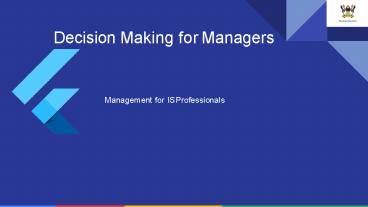Decision Making in Management PowerPoint PPT Presentation
Title: Decision Making in Management
1
Decision Making for Managers
Management for IS Professionals
2
Group Members
Name Registration no Email Signature
Shafiq Lutaaya 2018/HDO5/2094U Shafiq.Lutaaya_at_nwsc.co.ug
Maurice Elagu 2017/HD05/3184U mauriceelagu_at_gmail.com
Kawuba Elias 2018/HD05/3914U ellyias2013_at_gmail.com
Esther Nanyonga 2018/HD05/3915U enanyonga_at_gmail.com
Josephine Nakawuka 2017/HD05/3189U naksjoze_at_gmail.com
Musa Kintu 2018/HD05/2089U musakintu1_at_gmail.com
3
Objectives
-A decision -Managerial decision making -The
different types of decisions -Steps involved in
making decisions -Decision making incidences in
IS Management which would require the decision
making steps given above -Generic factors which
a manager should consider when evaluating
decision alternatives -Human biases that can
affect effective decision making -A learning
organization -Practices of a learning organization
4
A decision
A decision is a result of selection among several
options in response to opportunities and threats
by analyzing the available options. The options
could be facts, the law, or different ideas.
5
Managerial decision making
Decision making The process by which managers
respond to opportunities and threats by analyzing
options and deciding about goals and courses of
action. Decisions in response to
opportunities Managers respond to ways to improve
organizational performance. Decisions in
response to threats Occurs when managers are
impacted by adverse events to the organization.
6
The different types of decisions
- Programmed Decisions routine, almost an
automatic process. - Managers have made decision many times before.
- There are rules and guidelines to follow.
- Example Deciding to reorder office supplies.
- Non-programmed Decisions unusual situations that
have not been often addressed. - No rules to follow since the decision is new.
- These decisions are made based on information,
and a managers intuition, and judgment. - Example Should the firm invest in a new
technology?
7
Steps involved in making decisions
- Recognize a need for a decision. The first step
in making the right decision is recognizing the
problem or opportunity and deciding to address
it. Determine why this decision will make a
difference to your customers or fellow employees. - Frame the problem.
- Generate assess alternatives. Identify the
various solutions at your disposal.This helps you
determine which course of action is the best way
to achieve your objective. In assessing
alternatives, youll need to evaluate for
feasibility, acceptability and desirability to
know which alternative is bestPhil Higson and
Anthony Sturgess. - Choose among the alternatives.
- Implement the chosen alternative.
- Learn from feedback.
8
Decision making incidences in IS Management which
would require the decision making steps given
above
Marriot Tech. At Marriot Tech, we offer the best
IT services to our clients and have achieved a
vast amount of profits since we started. Being an
IT firm, we work with different technologies and
we recently learnt that there is a new
implementation technology on the market. This new
technology has many advantages but it also exerts
some power on our machines, but there is also
need to change to this new technology. This
matter will be left in the hands of Management as
it is a Management decision to make and will
require the decision making steps.
9
cont,. Decision making incidences in IS
Management which would require the decision
making steps given above Marriot Restaurant
Chain. As we begin the new financial year, there
is a proposal for the procurement of new
hardware. Some of reasons given are that our
hardware has become worn out and that there are
better options on the market. Nevertheless, most
of our hardware is still in good shape. This
matter will be left in the hands of Management as
it is a Management decision to make and will
require the decision making steps.
10
Generic factors which a manager should consider
when evaluating decision alternatives
- Legal.
- Managers must first be sure that an alternative
is legal both in this country and abroad for
exports. - Ethical.
- The alternative must be ethical and not hurt
stakeholders unnecessarily. - Economical feasibility
- Can our organizations performance goals sustain
this alternative? - Practicality
- Does the management have the capabilities and
resources to do it? - Value.
- Does the decision provide the best benefits and
have the highest value? - Strength.
- Does the decision work for the majority?
11
Human biases that can affect effective decision
making
Prior hypothesis bias. The manager allows strong
prior beliefs about a relationship between
variables and makes decisions based on these
beliefs even when evidence shows they are
wrong. Representativeness. The decision maker
incorrectly generalizes a decision from a small
sample or once incident. Illusion of control. The
manager over estimates their ability to control
events. Escalating commitment. The manager has
already committed considerable resource to the
project and wants to continue with it even after
feedback problems
12
A learning organization
In management, a learning organization is a
company that facilitates the learning of its
members and continuously transforms itself.
13
Practices of a learning organization
-Provide freedom to try new methods -Balance the
pressure of deadlines with opportunities for
innovation -Provide realistic, but challenging
goals -Encourage participation in decision making
and goal setting -Encourage the use of creative
problem solving for unstructured
problems -Encourage risk taking and buffer
negative forces -Seeks feedback -Provide time for
individual efforts -Listen effectively and watch
for nonverbal signals -Minimize direct
supervision as much as possible -Provide
resources and support priority work to
completion -Foster interaction and cooperation
with other work groups -Encourage lifelong
learning and professional growth
14
Thank you

